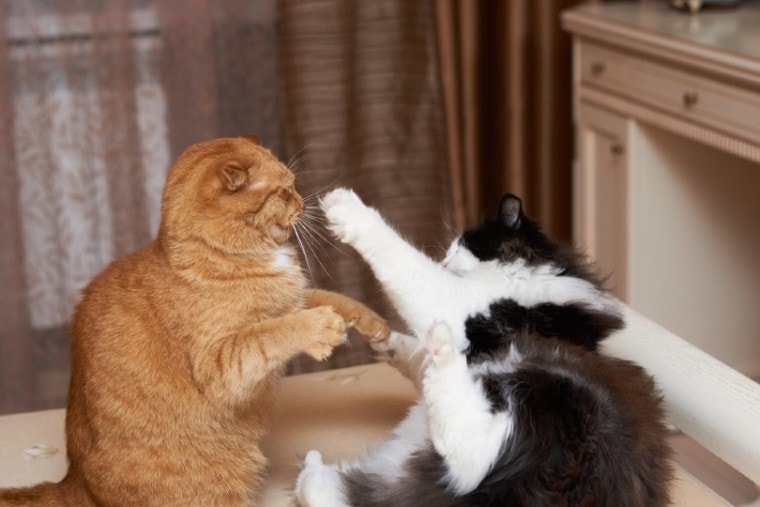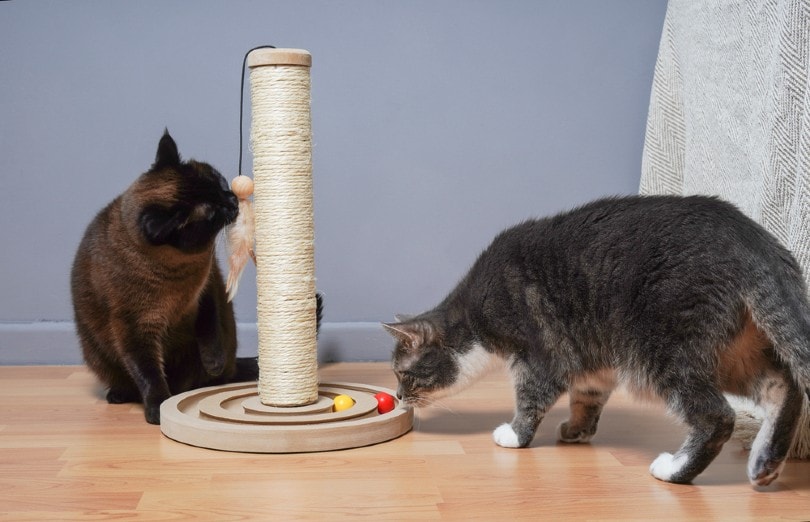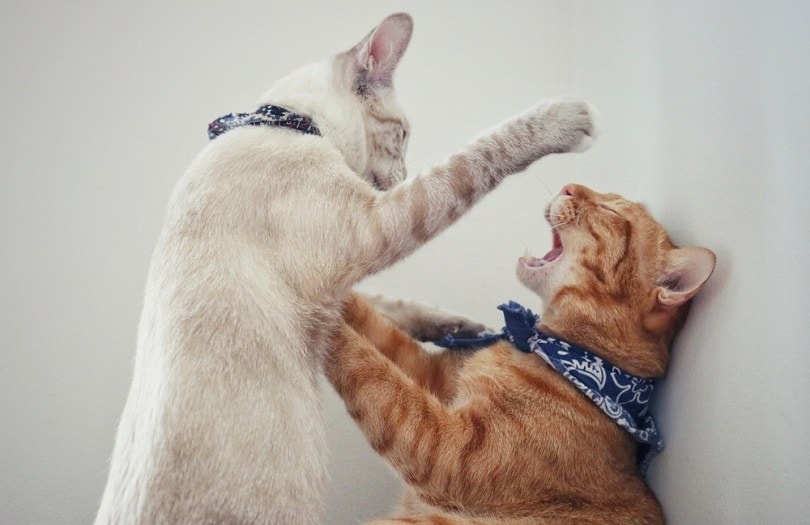
As much as you may like to have more than one cat inside your home, most cats don’t like having other cats in their territory. On average, it takes most cats between 8 months and 1 year to get along and become friends, though some cats never get along.
A variety of factors can impact how long it takes for cats to get along. For example, males take longer than females, and how you introduce the two cats matters a lot.
To learn more about getting two cats to get along inside your home, keep reading. This article covers how long it takes male and female cats to get along, explains why some cats never get along, and tells you how to introduce your cat to new cats for the best results.
 How Long Does It Take for Two Cats to Get Along?
How Long Does It Take for Two Cats to Get Along?
As we learned above, it takes an average of 8 to 12 months for two cats to get along, but that number can change based on the cat’s gender. By considering the cat’s gender, you will have a better idea of how long it may take for the cats to get along.

How Long Does It Take for Male Cats to Get Along?
In comparison to female cats, it takes male cats a little bit longer to get along with one another. Although the average for male cats is still between 8 and 12 months, you should expect it to take on the longer end of the spectrum for two male cats.
The reason why it takes male cats longer to get along is that males are often solitary in the wild. The only time male cats encounter other cats is when they are mating or fighting for their territory. Because this is their natural behavior, domesticated male cats often act the same way.
How Long Does It Take for Female Cats to Get Along?
In comparison to males, many females sometimes live together in the wild, which explains why females don’t take as long to get along. Most females can get along within 8 to 10 months, though some females may take shorter or longer.
It makes sense why females get along better with other cats than males. Unlike males, females help to raise kittens and spend part of their life with other cats. Because of this practice, it is easier for females to adjust to other cats simply because their nature has evolved in such a way.
That being said, female cats that live in colonies are often related to the cats around them. Hence, the cats all grew up with one another. So, female cats are still territorial and not used to living with cats they aren’t related to or already familiar with.

Other Factors to Consider
In addition to gender, the age of the cats, whether they are fixed, and individual personalities will impact how long it takes for cats to get along.
Cats that were raised together as kittens often don’t take months to get along since they were together since birth. The younger the cat is, the quicker they will likely get along with other cats. In contrast, many old cats do not like being introduced to new cats.
Whether or not your cat is fixed will hugely impact how they behave around other cats. Cats that are fixed often get along with other cats easily because they don’t have as much of a territorial drive. Getting a cat fixed will help them get along with other cats.
Lastly, the individual personality of your cat will impact how they behave around other felines. Just like humans, certain cats are more antisocial than others. Some cats may be open to getting new friends, whereas others may prefer a more solitary lifestyle.
Why Don’t All Cats Get Along?
Unfortunately, some cats will simply not ever get along. Unlike humans and dogs, cats are primarily solitary in the wild. Because of this fact, domesticated cats aren’t as open to living with other cats as guinea pigs, dogs, and other more social creatures.
Even female cats that spend part of their life with other cats and kittens may not enjoy being around cats their entire life. Cats need a whole lot of space and room to be by themselves. If there are too many cats, the cat may begin to feel overwhelmed and without adequate space, leading to behavioral problems.

Signs Cats Don’t Get Along
There are some signs you can look out for to determine if cats are not getting along. Any obvious signs of aggression show that cats do not get along, such as chasing, biting, swatting, or outright fighting. Some more subtle signs that cats don’t get along include squatting or flattening their ears.
Often, squatting, flattening ears, and hissing are precursors to fighting. Once the cats fight, it is unlikely that they will ever get along.
How to Introduce Your Cat to New Cats
Just as with humans, first impressions matter a lot with cats. If two cats fight outright on site, it is unlikely that they will ever get along because the cats will associate one another with fighting and territorial behavior. By introducing the cats to one another in a careful manner, you give your cats the best chance possible of getting along in the future.
Signs Your Cats Are Beginning to Get Along
Just as there are some signs that cats aren’t getting along, there are signs that they are. Any time you see cats touching each other in an affectionate manner, you know that the two cats like each other. For example, cats that get along will often rub their faces or bodies together.
Likewise, cats that get along won’t have any issues sitting with each other, sleeping with one another, and overall sharing their spaces.
Occasionally, there may be some differences among the cats, such as when the food is only offered to one. This is to be expected on occasion. Do your best to ensure all cats are given an equal amount of attention, care, and space.
 Conclusion
Conclusion
Predicting how long it will take for your cats to get along is not an exact science. On average, it takes cats between 8 and 12 months to get along, but gender, personality, and age can all impact the exact duration. Make sure to introduce the cats to one another slowly for best results and be patient during the entire process.
Featured Image Credit: Samarskiy, Shutterstock
 How Long Does It Take for Two Cats to Get Along?
How Long Does It Take for Two Cats to Get Along?




